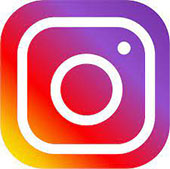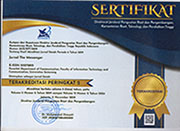The Meaning of Millennial Generation Text: Reception Analysis of #KidsJamanNow
Abstract
The term Kids Jaman Now (Children Today) appears on various social media sites through content that represents the activities of young people in the current era. There are more than 1.6 million pieces of content on Instagram and more than 270 thousand pieces of content on YouTube which use the hashtag Kids Jaman Now . Through these contents, young people are perceived as a narcissistic, individualistic generation with a setback in moral values. This study uses reception analysis by conducting in depth interviews on a number of millennial generation informants who consume Kids Jaman Now contents to find out how they interpret the content. This study aims to show that young people who use social media are not consumers who receive messages passively; they have critical power towards the content they consume as digital natives who have better literacy than previous generations. The millennial generation has three different acceptances of this phenomenon. The first considers the content of Kids Jaman Now to represent a narcissistic, individualistic, and deteriorating moral values generation. The second considers Kids Jaman Now content as creativity for young people who entertain others and master digital communication technology.
Keywords
Full Text:
PDFReferences
Adib, M. (2011). Filsafat Ilmu: Ontologi, Epistemologi, Aksiologi, dan Logika Ilmu Pengetahuan, Yogyakarta: Pustaka Pelajar. Fil-Safat Ilmu: Ontologi, Epistemologi, Aksiologi, dan Logika Ilmu Pengetahuan. Pustaka Pelajar.
Ahmad, A. (2012). Perkembangan Teknologi Komunikasi dan Kesenjangan Informasi: Akar Informasi dan Berbagai Standarnya. Jurnal Dakwah Tabligh, 13(1), 137 149.
Akqmie, N., Latiff, A., & Kee, C. P. (2021). Mediatisasi dan Budaya: Pengalaman Peminat Gen Z Gelombang Korea Malaysia Mengharungi Pandemik Global Covid-19. Jurnal Komunikasi: Malaysian Journal of Communication, 37(1), 314 333. https://doi.org/10.17576/JKMJC-2021-3701-18
Ashrianto, P. D., & Yustitia, S. (2020). The Use of Social Media in Searching for Information about Papua. Jurnal The Messenger, 12(2), 122. https://doi.org/10.26623/themessenger.v12i2.1939
Aydin, Z., Fuess, A., Sunier, T., & V ¡zquez, A. G. (2021). The web of hate: Fragmentation of media authority and its link to right-wing populism and cyber islamophobia. Jurnal Komunikasi: Malaysian Journal of Communication, 37(3), 231 243. https://doi.org/10.17576/JKMJC-2021-3703-13
Bencsik, A., & Machova, R. (2016). Knowledge sharing problems from the viewpoint of intergeneration management. ICMLG2016-4th International Conferenceon Management, Leadership and Governance: ICMLG2016, 42.
Bungin, B. (2013). Metodologi Penelitian Kuantitatif. Kencana Prenada Media Group.
Candrasari, Y. (2021). Nonverbal Communication Reconstruction on Facebook. Jurnal The Messenger, 13(1), 94. https://doi.org/10.26623/themessenger.v13i1.1000
Chen, C.-P. (2014). Forming digital self and parasocial relationships on YouTube. Journal of Consumer Culture, 16(1), 232 254. https://doi.org/10.1177/1469540514521081
Chen, H. (2018). College-Aged Young Consumers Perceptions of Social Media Marketing: The Story of Instagram. Journal of Current Issues and Research in Advertising, 39(1), 22 36. https://doi.org/10.1080/10641734.2017.1372321
Denson, T. F., DeWall, C. N., & Finkel, E. J. (2012). Self-control and aggression. Current Directions in Psychological Science, 21(1), 20 25.
Duntari, R. A. A., & Riska Hidayat, R. I. (2018). Polemik Kids Jaman Now Ditinjau Dari Aspek Perkembangan Sosial. Fokus, 1(Januari), 27 36.
Ellison, N. B., Gray, R., Lampe, C., & Fiore, A. T. (2014). Social capital and resource requests on Facebook. New Media & Society, 16(7), 1104 1121. https://doi.org/10.1177/1461444814543998
Faiqah, F., Nadjib, M., & Amir, A. S. (2016). Youtube Sebagai Sarana Komunikasi Bagi Komunitas Makassarvidgram. Jurnal Komunikasi KAREBA, 16(1), 259 272. https://doi.org/10.1080/14639947.2015.1006801
Fiaji, N. A. (2018). Pergeseran Nilai Moral Dalam Meme Kids Jaman Now. WASKITA: Jurnal Pendidikan Nilai Dan Pembangunan Karakter., 2(1). https://doi.org/https://doi.org/10.21776/ub.waskita.2018.002.01.7
Gangneux, J. (2019). Logged in or locked in? Young adults negotiations of social media platforms and their features. Journal of Youth Studies, 22(8), 1053 1067. https://doi.org/10.1080/13676261.2018.1562539
Garc a Jim ©nez, A., & Montes Vozmediano, M. (2020). Subject matter of videos for teens on YouTube. International Journal of Adolescence and Youth, 25(1), 63 78. https://doi.org/10.1080/02673843.2019.1590850
Hall, S. (1997). Theory of Representation. Sage Publications.
Hidayatullah, S., Waris, A., & Devianti, R. C. (2018). Perilaku Generasi Milenial dalam Menggunakan Aplikasi Go-Food. Jurnal Manajemen Dan Kewirausahaan, 6(2), 240 249. https://doi.org/10.26905/jmdk.v6i2.2560
Ibrahim, S. (2011). Kritik Budaya Komunikasi. Yogyakarta: Jalasutra.
Jatmiko, L. D. (2020). APJII: 196.7 Juta Warga Indonesia Sudah Melek Internet. bisnis.com, 1 9.
Khamis, S., Ang, L., & Welling, R. (2017). Self-branding, micro-celebrity and the rise of Social Media Influencers. Celebrity Studies, 8(2), 191 208. https://doi.org/10.1080/19392397.2016.1218292
Khan, M. L. (2017). Social media engagement: What motivates user participation and consumption on YouTube? Computers in Human Behavior, 66, 236 247. https://doi.org/https://doi.org/10.1016/j.chb.2016.09.024
Kuncoro, A. M., Putri, A. O., & Pradita, A. (2018). Vlogger Sebagai Saluran Menuju Generasi Milenial Produktif Indonesia. Sinergitas Quadruple Helix: E-Business Dan Fintech Sebagai Daya Dorong Pertumbuhan Ekonomi Lokal, 193 199.
Lee, S., & Kim, E. (2020). Influencer marketing on Instagram: How sponsorship disclosure, influencer credibility, and brand credibility impact the effectiveness of Instagram promotional post. Journal of Global Fashion Marketing, 11(3), 232 249. https://doi.org/10.1080/20932685.2020.1752766
Medcom.id. (2017). Mengenal Generasi Milenial dan Kids Zaman Now. 1 11.
Mosley, D. V., Abreu, R. L., Ruderman, A., & Crowell, C. (2017). Hashtags and hip-hop: exploring the online performances of hip-hop identified youth using Instagram. Feminist Media Studies, 17(2), 135 152. https://doi.org/10.1080/14680777.2016.1197293
Mulyadi, U., & Fitriana, L. (2018). Hashtag (#) as Message Identity in Virtual Community. Jurnal The Messenger, 10(1), 44. https://doi.org/10.26623/themessenger.v10i1.671
Musya adah, U. (2018). Arti Seorang Pendidik Untuk Kids Zaman Now Analisa Kritis Terhadap Pendidik dalam Pendidikan Islam. Modeling, 5(2), 157 174. http://jurnal.stitnualhikmah.ac.id/index.php/modeling/article/view/332.
Naldo, H. W. S. (2018). Studi Observasi terhadap Penggunaan Aplikasi LINE oleh Generasi Millenial. Jurnal Sosial Humaniora Terapan, 1(1), 32 40. https://doi.org/10.7454/jsht.v1i1.33
Nurhadi, Z. F., Salamah, U., & Yuniar, A. A. (2020). Motif Penggunaan Youtube Sebagai Media Informasi. Commed: Jurnal Komunikasi Dan Media, 4(2), 170 190.
Nuriana, D., Rizkiyah, I., Efendi, L., Wibowo, H., & Raharjo, S. T. (2019). Generasi Baby Boomers (Lanjut Usia) Dalam Menghadapi Era Revolusi Industri 4.0. Focus : Jurnal Pekerjaan Sosial, 1(32). https://doi.org/https://doi.org/10.24198/focus.v2i1.23117
Palinoan, I. Y. (2017). Dampak Tayangan Vlog Di Youtube Terhadap Gaya Hidup Hedonis Siswa. Jurnal Ilmu Komunikasi Universitas Mulawarman.[Online], 5(2), 215 225.
Parry, E., & Urwin, P. (2011). Generational differences in work values: A review of theory and evidence. International Journal of Management Reviews, 13(1), 79 96.
Pires, F., Masanet, M. J., & Scolari, C. A. (2021). What are teens doing with YouTube? Practices, uses and metaphors of the most popular audio-visual platform. Information Communication and Society, 24(9), 1175 1191. https://doi.org/10.1080/1369118X.2019.1672766
Prianto, J. (2014). Cantik: Panduan Lengkap Merawat Kulit Wajah. Gramedia Pustaka Utama.
Putra, Y. S. (2018). Theoritical Review : Teori Perbedaan Generasi. Among Makarti, 9(1), 123 134.
Raby, R., Caron, C., Th ©wissen-LeBlanc, S., Prioletta, J., & Mitchell, C. (2018). Vlogging on YouTube: the online, political engagement of young Canadians advocating for social change. Journal of Youth Studies, 21(4), 497 514. https://doi.org/10.1080/13676261.2017.1394995
Rahman, T., Nurnisya, F. Y., Nurjanah, A., & Hifziati, L. (2021). Hijrah and the articulation of islamic identity of indonesian millenials on instagram. Jurnal Komunikasi: Malaysian Journal of Communication, 37(2), 154 170. https://doi.org/10.17576/JKMJC-2021-3702-10
Rahmawati, A. (2021). Manufacturing Authenticity: The Rise of Indonesian Micro-Celebrities on Instagram. Jurnal The Messenger, 13(1), 108. https://doi.org/10.26623/themessenger.v13i1.999
Rashid, J. A., Aziz, A. A., Rahman, A. A., Saaid, S. A., Ahmad, Z., & Zainodin, W. H. W. (2020). The influence of mobile phone addiction on academic performance among teenagers. Jurnal Komunikasi: Malaysian Journal of Communication, 36(3), 408 424. https://doi.org/10.17576/JKMJC-2020-3603-25
Rootsi, S., Behar, D. M., J ¤rve, M., Lin, A. A., Myres, N. M., Passarelli, B., Poznik, G. D., Tzur, S., Sahakyan, H., & Pathak, A. K. (2013). hylogenetic applications of whole Y-chromosome sequences and the Near Eastern origin of Ashkenazi Levites. Nature Communications, 4(1), 1 9.
Rosidi, I. (2020). Consuming Representations of Korean TV Dramas among Indonesian Muslim Youth. Jurnal The Messenger, 12(2), 111. https://doi.org/10.26623/themessenger.v12i2.2115
Sari, E. A. (2020). Pengaruh Aktifitas Penelusuran Informasi Terhadap Jejak Digital Di Youtube Bagi Generasi Millenial. BIBLIOTIKA : Jurnal Kajian Perpustakaan Dan Informasi, 4(1), 42 55.
Schwartz, S. J., Zamboanga, B. L., Meca, A., & Ritchie, R. A. (2012). Identity around the world: An overview. New Directions for Child and Adolescent Development, 2012(138), 1 18.
Scolari, C. A., & Fraticelli, D. (2017). The case of the top Spanish YouTubers: Emerging media subjects and discourse practices in the new media ecology. Convergence, 25(3), 496 515. https://doi.org/ttps://doi.org/10.1177/1354856517721807
Scolari, C., Masanet, M.-J., Guerrero-Pico, M., & Establ ©s, M.-J. (2018). Transmedia literacy in the new media ecology: Teens transmedia skills and informal learning strategies. El Profesional de La Informacion, 27(4), 801 812. https://doi.org/https://doi.org/10.3145/epi.2018.jul.09
Sianipar, A. P. (2013). Pemanfaatan youtube di kalangan mahasiswa. Jurnal Pendidikan, 2.
Soerjoatmodjo, S. P. G. (2018). Membangun Karakter Kebangsaan Kids Zaman Now. Infobintaro.
Suherman, M. (2016). Efektivitas Strategi Permainan Dalam Mengembangkan Self-Control Siswa. Jurnal Penelitian Pendidikan, 16(2), 194 201.
Supratman, L. P. (2018). Penggunaan Media Sosial oleh Digital Native. Jurnal Ilmu Komunikasi, 15(1), 47 60. https://doi.org/10.24002/jik.v15i1.1243
Suryadi, B. (2015). Generasi y: karakteristik, masalah, dan peran konselor. Seminar dan Workshop Internasional MALINDO 4. https://repository.uinjkt.ac.id/dspace/handle/123456789/34351
Syafrida Febriyanti, R. T. (2019). Youth Identity in Social Media (Virtual Ethnography Studies of Youth Identity Construction on Kids Jaman Now Content Youtube Channels). 2018(2018), 520 526. https://doi.org/10.11594/nstp.2019.0271
Syam, H. M., & Nurrahmi, F. (2020). I Don t Know If It Is Fake or Real News How Little Indonesian University Students Understand Social Media Literacy. Jurnal Komunikasi: Malaysian Journal of Communication, 36(2), 92 105. https://doi.org/10.17576/JKMJC-2020-3602-06
Syukron, A. A. (2018). Pendidikan Moral Kids Zaman Now dalam Perspektif Islam. JPAI, 4(2), 159 179. https://doi.org/https://doi.org/10.18860/jpai.v4i2.4620
Tutiasri, R. P., & Kusuma, A. (2020). Millennial generation and family literacy within the dissemination of hoax in Whatsapp group. Informasi, 50(2), 153 164.
Vromen, A., Xenos, M. A., & Loader, B. (2015). Young people, social media and connective action: from organisational maintenance to everyday political talk. Journal of Youth Studies, 18(1), 80 100. https://doi.org/10.1080/13676261.2014.933198
West, R., & Turner, L. (2014). Pengantar Teori Komunikasi: Analisis dan Aplikasi, Terjemah oleh Brian Marswendy. Jakarta: Salemba Humanika.
Widika, T. (2018). Sejarah Berdirinya YouTube--Sejarah Dunia. Canacantya. https://canacantya.wordpress.com/sejarah/sejarah-berdirinya-YouTube/
Yusuf, S. (2016). Psikologi perkembangan anak & remaja. Remaja Rosdakarya.
Yuswohady. (2016). Millennial Trends 2016. Yuswohady. https://www.yuswohady.com/2016/01/17/millennial-trends-2016/
Zulfah, S. (2018). Pengaruh Perkembangan Teknologi Informasi Lingkungan (Studi Kasus Kelurahan Siti Rejo I Medan). Buletin Utama Teknik, 13(2), 2.
DOI: http://dx.doi.org/10.26623/themessenger.v13i2.1007
Refbacks
- There are currently no refbacks.
Copyright (c) 2021 Jurnal The Messenger
View My Stats [Jurnal The Messenger] is an International Scientific Journal, Published by the Department of Communication, Faculty of Information Technology and Communication, Universitas Semarang (Central Java, Indonesia). It is licensed under a Creative Commons Attribution 4.0 International License.



_11.jpg)




_BARCODE.jpg)
_BARCODE1.jpg)


5.png)










2.png)





